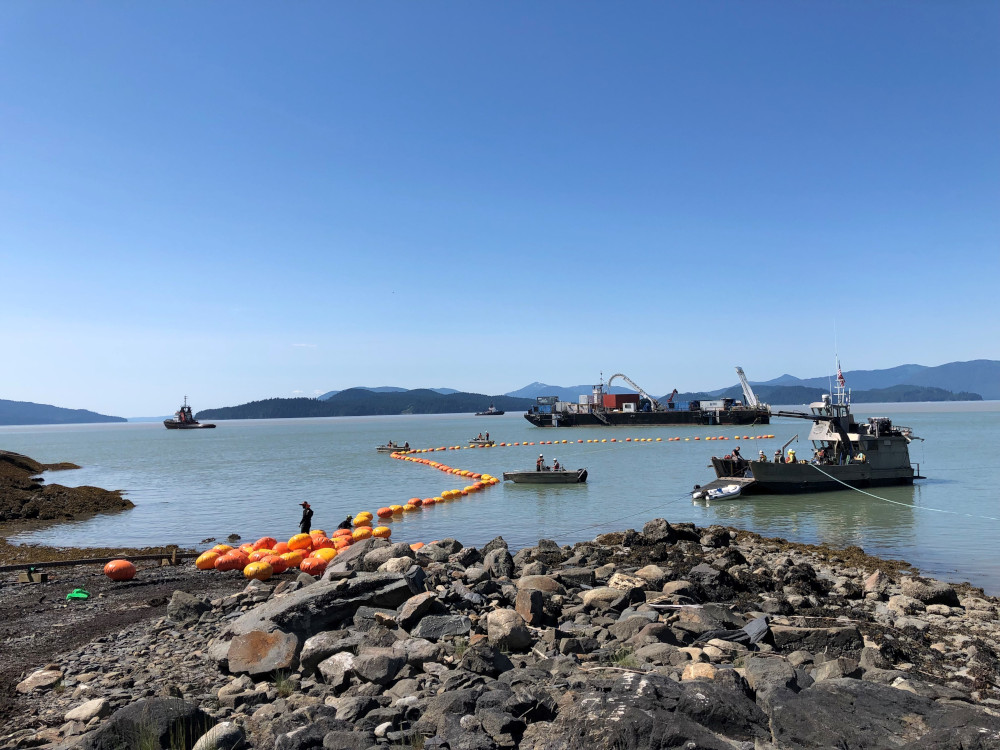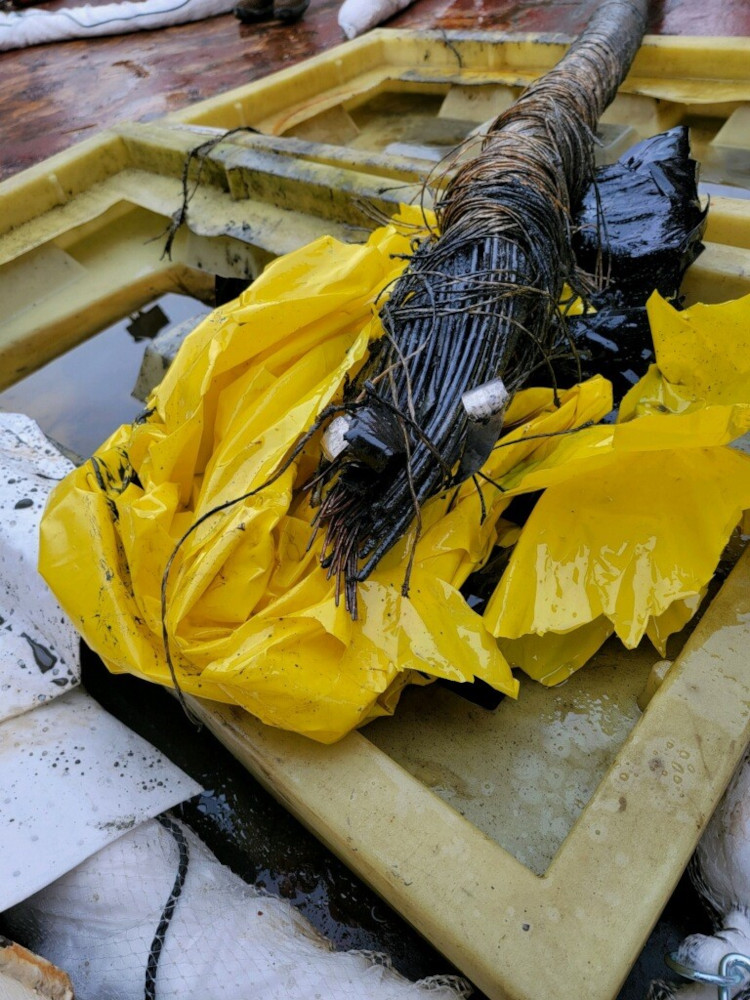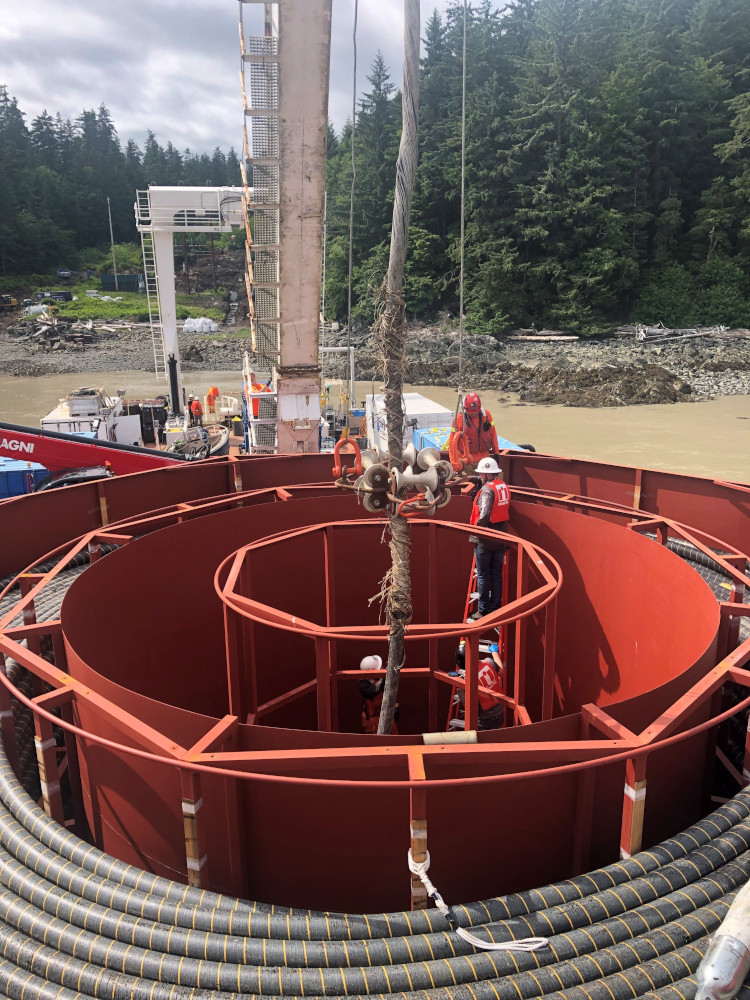
Companies installed a new underwater electrical transmission line between Wrangell and Petersburg in July. Some work remains before that new power line is supplying electricity to Petersburg. And it’s not yet clear what broke the old cable.
The new three and a half miles of transmission line replaces a section of the Southeast power grid that failed in September of 2019. It’s between Vank and Woronkofski islands, near Wrangell and crosses a section of the Stikine Strait that gets as deep as 700 feet.
Trey Acteson is CEO of the Southeast Alaska Power Agency, which sells hydroelectricity to utilities in Ketchikan, Wrangell and Petersburg. He said the work has gone well.
“Folks might have saw the barge out there over the Fourth of July period,” Acteson said. “We mobilized up there right at the beginning of the month and the installation removal barge mobilized with a couple of tugs and three more other boats, support boats and then also a dive boat as well.”
SEAPA is contracting with Japanese multinational Sumitomo, along with several subcontractors, for manufacturing and installation of the new power line along with removal of the old one that failed.
The old line dates back to the early 1980s. It’s one of four single-phase conductors used to transport power between islands. Workers were able to pull up the three and a half inch diameter cable and found it had almost completely broken in one spot, with one remaining strand of the line stretched about 20-30 meters.
Acteson did not see any wearing on the outside of the line and said it’s too early to draw any conclusions on the cause of the failure.
“Of course the insurance company is going to do their own investigation and try to make a determination on the root cause of the failure,” Acteson said. “Just simple observation of the ends that were retrieved, it appears that there was a sudden breakage in the cable. So some type of an underwater event triggered that. It could have been sediment, maybe perhaps a cornice of sediment that had built up on top of a ledge there and it cut loose and had broken the cable, or something of that nature.”

Workers used a remotely operated vehicle in retrieving that old power line and positioning the new one on the ocean floor. Acteson said they avoided and later retrieved a number of lost boat anchors in that installation.

The new power line cost millions to manufacture and ship over from Japan. Acteson described watching the precision work.
“So first of all there’s that kind of nervous part where you have to cut the cable and you got to make sure it’s correct,” he said. “So they have three different ways of measuring that cable length just to confirm that they’ve got it correct because you know first all you’ve got the cable pulled up from the bottom and it’s hanging off the back of the boat. So you have some angles and some calculations. And then you have the distance to shore and then you have the distance that you have to take it up to the final terminations and it cant be too long.”
The old link is comprised of four separate power lines, with one redundant, each providing one part of the three-phase electricity. It’s the same system used on SEAPA’s other submarine cable crossings. The three that remained kept Petersburg connected to cheap hydro power for nearly two years.
Petersburg’s utility director Karl Hagerman noted the community would have been forced to rely on much more costly diesel power during that time if any of the other three lines had gone.
“Yes everybody at the power plant is breathing much easier to have that cable in place and knowing that that redundancy is there,” Hagerman said.
The new cable, around six inches in diameter, has all three conductors bundled together. The power provider can still use the old group of three remaining cables, along with this new connection as needed.
It’ll be another two to three weeks to complete the connection and test the transition from the underwater line to above ground power lines. Customers in Petersburg will notice backup diesel generators running from time to time while that work continues.
The power provider has had several large expansion projects over the past few decades. SEAPA connected its two hydroelectric plants, one near Ketchikan and one near Wrangell, in 2009. It also boosted capacity, raising the level of the Swan Lake Dam near Ketchikan in 2016. But this cable work is one of the largest replacements of the original system.
SEAPA’s Acteson noted it’s another good example of spreading out the cost of major projects to the three communities.
““For just a single community to have to take on a 10-20 million dollar project by themselves that’s a heavy lift and when you can spread those costs over a wider base it really benefits all at the end of the day,” he said.
SEAPA is bonding for more than 13 million dollars with the Alaska Municipal Bond Bank to pay for the work. The SEAPA board this fall is expected to consider increasing the wholesale cost of electricity to repay that debt. That could mean incremental rate hikes for the utilities in all three communities.










